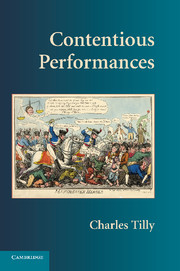Book contents
- Frontmatter
- Contents
- Boxes, Figures, and Tables
- Preface
- Contentious Performances
- 1 CLAIMS AS PERFORMANCES
- 2 HOW TO DETECT AND DESCRIBE PERFORMANCES AND REPERTOIRES
- 3 HOW PERFORMANCES FORM, CHANGE, AND DISAPPEAR
- 4 FROM CAMPAIGN TO CAMPAIGN
- 5 INVENTION OF THE SOCIAL MOVEMENT
- 6 REPERTOIRES AND REGIMES
- 7 CONTENTION IN SPACE AND TIME
- 8 CONCLUSIONS
- References
- Index
5 - INVENTION OF THE SOCIAL MOVEMENT
Published online by Cambridge University Press: 05 June 2012
- Frontmatter
- Contents
- Boxes, Figures, and Tables
- Preface
- Contentious Performances
- 1 CLAIMS AS PERFORMANCES
- 2 HOW TO DETECT AND DESCRIBE PERFORMANCES AND REPERTOIRES
- 3 HOW PERFORMANCES FORM, CHANGE, AND DISAPPEAR
- 4 FROM CAMPAIGN TO CAMPAIGN
- 5 INVENTION OF THE SOCIAL MOVEMENT
- 6 REPERTOIRES AND REGIMES
- 7 CONTENTION IN SPACE AND TIME
- 8 CONCLUSIONS
- References
- Index
Summary
On 19 August 1765, the Boston Gazette published a colorful account of recent doings in central Boston:
Early on Wednesday morning last the Effigy of a Gentleman sustaining a very unpopular office, viz. that of St – p Master, was found hanging on a Tree in the most public Part of the Town, together with a Boot, wherein was concealed a young Imp of the D – l represented as peeping out of the Top – On the Breast of the Effigy was a Label in Praise of Liberty, and denouncing Vengeance on the Subverters of it – and underneath was the following Words, HE THAT TAKES THIS DOWN IS AN ENEMY TO HIS COUNTRY. – The Owner of the Tree finding a Crowd of People to assemble, tho' at 5 o'Clock in the Morning, endeavored to take it down; but being advised to the contrary by the Populace, lest it should occasion the Demolition of his Windows, if nothing worse, desisted from the Attempt.
The effigy-bearing tree became famous as the Liberty Tree. It served first as a rallying-point for Boston's patriots, then as a model for other colonial cities, and finally as a symbol of revolution in Western Europe, including the Netherlands, France, and Great Britain. Boston's early-morning tableau mingled visions of violence and of disciplined patriotism.
Effigies, their parading, and their ultimate destruction often figured in Boston's popular celebrations. They appeared notably in the anti-Catholic Pope's Day festivities organized by rival groups from the North and South Ends.
- Type
- Chapter
- Information
- Contentious Performances , pp. 116 - 145Publisher: Cambridge University PressPrint publication year: 2008

